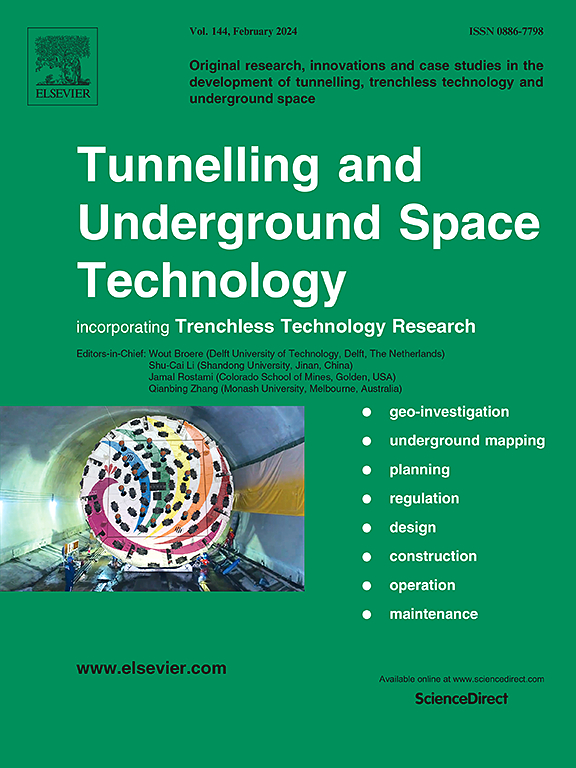Temperature decay and heat exhaust efficiency under ceiling multi-point centralized smoke exhaust in a ventilated tunnel
IF 6.7
1区 工程技术
Q1 CONSTRUCTION & BUILDING TECHNOLOGY
引用次数: 0
Abstract
Tunnel fire is one of the major challenges that cannot be ignored in the safe operation of tunnels. Considering the structure characteristics and bigger heat release rates of tunnel fires, multi-point centralized smoke exhaust coupling with longitudinal ventilation mode is practical in tunnel engineering project, which is significantly important to study the ceiling longitudinal temperature decay and heat exhaust efficiency of such tunnels. Experimental tests are conducted. The experimental variables include heat release rate, number of smoke vents and smoke exhaust volume, while maintaining the longitudinal wind speed at the critical velocity during the experiment. The results show that the tunnel ceiling smoke temperature significantly decreases after passing through the smoke exhaust vent, and the temperature decreases rapidly with the increase of smoke exhaust volume. When there are multiple smoke exhaust vents, the tunnel ceiling temperature between the smoke exhaust vents shows a significant segmented decay trend. The sudden decrease in temperature caused by smoke exhaust only affects the overall change in ceiling temperature and does not affect the decay trend of ceiling temperature. The empirical coefficient was proposed to characterize the reduction effect of smoke exhaust on the ceiling longitudinal temperature, the smoke exhaust efficiency was calculated. The correlation between empirical coefficient , heat exhaust efficiency , dimensionless smoke exhaust volume , and dimensionless heat release rate was proposed. The correlation between the longitudinal profile difference of CO concentration and smoke temperature and smoke exhaust volume was obtained. The correlation between coefficient and heat exhaust efficiency has been verified. The research results can provide support for tunnel fire safety and tunnel fire hazard rescue.
通风隧道吊顶多点集中排烟下的温度衰减与排热效率
隧道火灾是隧道安全运行中不可忽视的重大挑战之一。考虑到隧道火灾的结构特点和较大的放热速率,多点集中排烟耦合纵向通风方式在隧道工程中是可行的,研究隧道顶棚纵向温度衰减和排热效率具有重要意义。进行了实验测试。实验变量包括放热率、排烟口数、排烟量,实验过程中保持纵向风速为临界风速。结果表明:隧道顶板烟温通过排烟口后显著降低,且随着排烟量的增大,烟温迅速降低;当有多个排烟口时,排烟口之间的隧道顶板温度呈明显的分段衰减趋势。排烟引起的温度突然下降只影响吊顶温度的整体变化,不影响吊顶温度的衰减趋势。提出了用经验系数β来表征排烟对顶棚纵向温度的降低效果,计算了排烟效率E。提出了经验系数β、热效率E、无因次排烟量V *和无因次放热率Q *之间的相关关系。得到了CO浓度纵剖面差与烟温、排烟量的相关性。验证了系数β与排热效率之间的相关性。研究结果可为隧道消防安全和隧道火灾救援提供支持。
本文章由计算机程序翻译,如有差异,请以英文原文为准。
求助全文
约1分钟内获得全文
求助全文
来源期刊

Tunnelling and Underground Space Technology
工程技术-工程:土木
CiteScore
11.90
自引率
18.80%
发文量
454
审稿时长
10.8 months
期刊介绍:
Tunnelling and Underground Space Technology is an international journal which publishes authoritative articles encompassing the development of innovative uses of underground space and the results of high quality research into improved, more cost-effective techniques for the planning, geo-investigation, design, construction, operation and maintenance of underground and earth-sheltered structures. The journal provides an effective vehicle for the improved worldwide exchange of information on developments in underground technology - and the experience gained from its use - and is strongly committed to publishing papers on the interdisciplinary aspects of creating, planning, and regulating underground space.
 求助内容:
求助内容: 应助结果提醒方式:
应助结果提醒方式:


